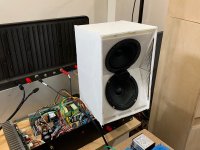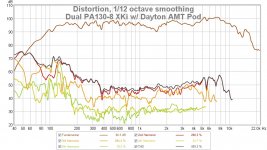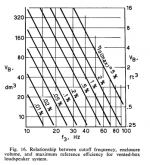Pretty different drivers from a design standpoint but both intend to satisfy in a fullrange environment
Anyone challenge the two head to head?..... both are highly regarded and very similiar in price point.
Anyone challenge the two head to head?..... both are highly regarded and very similiar in price point.
We bought a batch of FR88ex when the FF85k was discontinued and there was no replacement in site. This led to the Fountek Five. I still have 5 of them left. They are a decent driver.
Then the FF85wk came out. We much prefer it.
dave
Then the FF85wk came out. We much prefer it.
dave
This guy rates the 88!
Timothy Feleppa's Pages: Speaker Measurements - Midrange/Fullrange Speakers 4" and smaller
Timothy Feleppa's Pages: Speaker Measurements - Midrange/Fullrange Speakers 4" and smaller
Yes.......by measured response and distortion.......and within the context of an objective comparison......the two are a toss up IMO. Side by side in a box playing music, I would expect the differences to be more apparent.
Those are my measurements btw.
FR88 will sound better once you equalize the FR to be flat - it's about 4dB louder from 2kHz up which will make it sound very bright when run full range without any filter/EQ.
FF85WK needs less work on that front - just toeing them in/out will achieve almost ruler flat frequency response, or you can add a mild notch filter or just live with some extra sizzle in the treble. It's also more sensitive so a better match for low power amps. But its distortion is a little worse than the FR88, something you can't improve by tweaking. It's not bad per se, just does not have as much potential as the FR88 for that reason.
If you're planning on listening to either of these at any decent volume from more than a metre away I think you'll be sorely disappointed. A 3" driver will only produce acceptable bass at higher volumes if you use them as desktop/near-field monitors.
FR88 will sound better once you equalize the FR to be flat - it's about 4dB louder from 2kHz up which will make it sound very bright when run full range without any filter/EQ.
FF85WK needs less work on that front - just toeing them in/out will achieve almost ruler flat frequency response, or you can add a mild notch filter or just live with some extra sizzle in the treble. It's also more sensitive so a better match for low power amps. But its distortion is a little worse than the FR88, something you can't improve by tweaking. It's not bad per se, just does not have as much potential as the FR88 for that reason.
If you're planning on listening to either of these at any decent volume from more than a metre away I think you'll be sorely disappointed. A 3" driver will only produce acceptable bass at higher volumes if you use them as desktop/near-field monitors.
Last edited:
My desktops are FE85's with some slight mod of dopeing the dustcap which helped breakup immensely. Full range? Well I thought so but it did not take long to put on a tweeter. Not just for response, but to control the breakup. Their brightness is not rising response, it is breakup! Deal with it and you will be happier. (3/4 inch, first order @ 5K) Am I slamming them? NO. Been using them happily for years. Getting real 85Hz in 3L ( added mass with the doping)
I tried for several years to work with full-range. Mark, Fostex, Fountek, Hi-Vi, conventional cone drivers. Every time, it turned out the old decade rule proved itself. What I did not get to do is use large arrays of full ranges. What would a dozen FE85's do? Might change my mind.
I tried for several years to work with full-range. Mark, Fostex, Fountek, Hi-Vi, conventional cone drivers. Every time, it turned out the old decade rule proved itself. What I did not get to do is use large arrays of full ranges. What would a dozen FE85's do? Might change my mind.
If you're planning on listening to either of these at any decent volume from more than a metre away I think you'll be sorely disappointed. A 3" driver will only produce acceptable bass at higher volumes if you use them as desktop/near-field monitors.
While the lack of cone area limits their loudness capabilities, it is very revelaing to watch someone’s face while listening to some bass heavy tracks when 1st exposed to Frugel-Horn Lite with FF85wk or Alpair 5.2/3.
dave
Won't fit on my desk. 🙂 A really good example of how far you can push something but in the end, physics still rules.
Those are my measurements btw.
FR88 will sound better once you equalize the FR to be flat - it's about 4dB louder from 2kHz up which will make it sound very bright when run full range without any filter/EQ.
FF85WK needs less work on that front - just toeing them in/out will achieve almost ruler flat frequency response, or you can add a mild notch filter or just live with some extra sizzle in the treble. It's also more sensitive so a better match for low power amps. But its distortion is a little worse than the FR88, something you can't improve by tweaking. It's not bad per se, just does not have as much potential as the FR88 for that reason.
If you're planning on listening to either of these at any decent volume from more than a metre away I think you'll be sorely disappointed. A 3" driver will only produce acceptable bass at higher volumes if you use them as desktop/near-field monitors.
Thanks for the reply. The ‘plan’ is a near field mix monitor at 1m.....supplimental to my existing monitors......and then.....IF the midrange window they provide proves to be beneficial to my workflow, i’d Use them as a midrange driver in a custom built three way.
......and yes, as suggested here I bought a pair of SS 10F and ran them as such as passive with an older Bryson pre and power set.......I could NOT bond with them or make any mix decisions that made appreciable improvement in the 700hz-4khz range. Not suggesting the Fostex or Fountek will be any better.... but worth a try before purchasing a set of Avantones.
The Avantone Mixcubes look like a 525in full range in a 6.5in cube cabinet. Try a PA130-8 in similar cube with a rear reflex vent tuned for 90Hz and some BSC, and you can probably get a similar sound. I don't believe the 93dB sensitivity rating they state (maybe at 1kHz and no BSC applied) but there is no way they get 93dB at 90Hz from a cabinet that small and driver that small. I built a dual PA130-8 with a helper Dayton AMT (pod) supertweeter, and it acheives some really high sensitivity at 4ohms. Sounds very nice - tuned to about 100Hz with two slot reflex ports. I was going for an XKi but the aperture messed up the sound so I play it open face now. I would say that if you cut this box in half, it would be close to the Avantone box in size. The dual drivers has impressive sensitivity and higher SPL capability though.

It really should have a 100Hz high pass cap to reduce the excursion below that adds to distortion.

It really should have a 100Hz high pass cap to reduce the excursion below that adds to distortion.
Attachments
Last edited:
The Avantone Mixcubes look like a 525in full range in a 6.5in cube cabinet. Try a PA130-8 in similar cube with a rear reflex vent tuned for 90Hz and some BSC, and you can probably get a similar sound. I don't believe the 93dB sensitivity rating they state (maybe at 1kHz and no BSC applied) but there is no way they get 93dB at 90Hz from a cabinet that small and driver that small. I built a dual PA130-8 with a helper Dayton AMT (pod) supertweeter, and it acheives some really high sensitivity at 4ohms. Sounds very nice - tuned to about 100Hz with two slot reflex ports. I was going for an XKi but the aperture messed up the sound so I play it open face now. I would say that if you cut this box in half, it would be close to the Avantone box in size. The dual drivers has impressive sensitivity and higher SPL capability though.
It really should have a 100Hz high pass cap to reduce the excursion below that adds to distortion.
No need for high efficiency......Watts are cheap these days.
Like the Yamaha Ns10.....the sealed alignment and controlled impulse response help with upper bass and lower midrange clarity which is a blessing during mixdown......but for casual listening, not so much.
It's surprising how few people have used that approach; it's been around since mammoth roamed the Earth, but usually under the radar. OK, mechanical solutions like resistive venting have an appeal if you need more LF damping in a given driver / sealed box combination, but a large value series cap can be a viable electrical option if the mechanical isn't preferred for xyz reason.
Cost of ne plus ultra audiophool grade film etc, caps of such values can easily approach or surpass that of many of the more affordable FR/wideband drivers commonly played around with by the frugality minded.
True. I've tried it twice, once with a bipolar electrolytic, the second with a Jantzen CrossCap. Latter (a regular axial MKP cap) cost about £30 per channel in the relatively large value necessary, so not very practical for cheap drivers, but viable for pricier products if mechanical solutions aren't desired. Less so for those into exotic snake oi- sorry, capacitors of course... 😉
Last edited:
- Home
- Loudspeakers
- Full Range
- FF85WK vs FR88?



